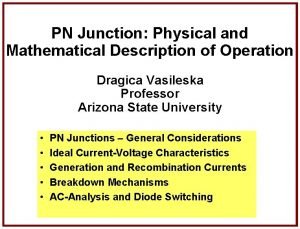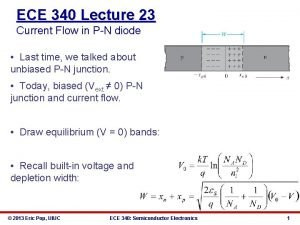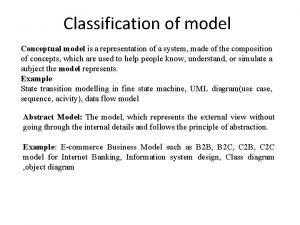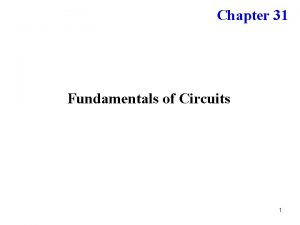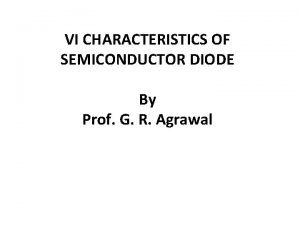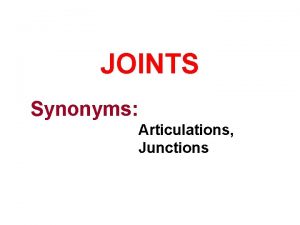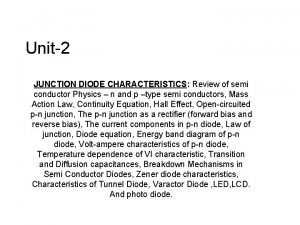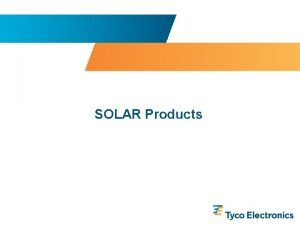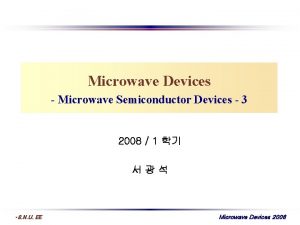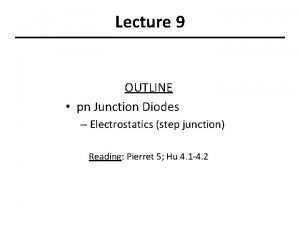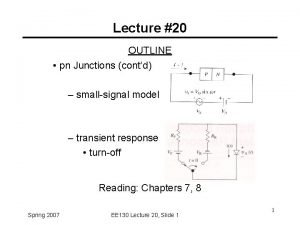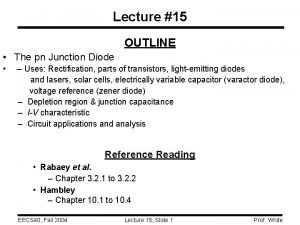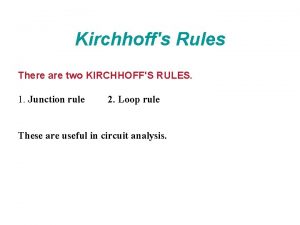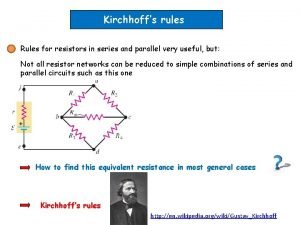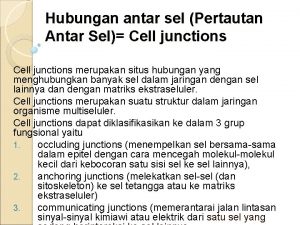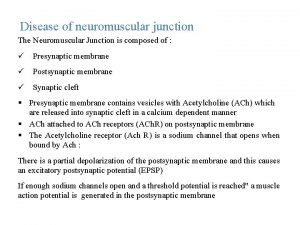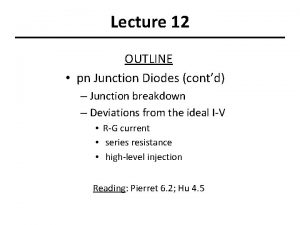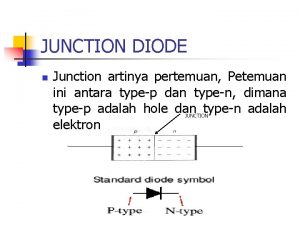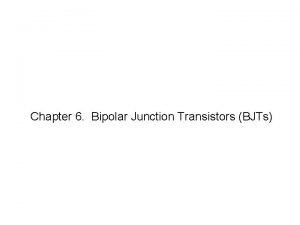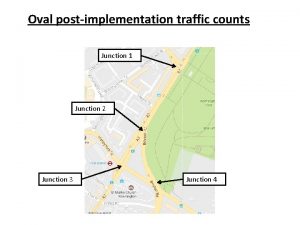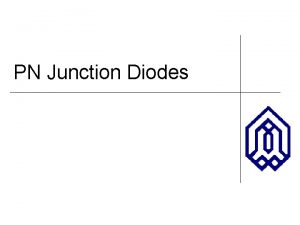PN Junction Physical and Mathematical Description of Operation













































- Slides: 45

PN Junction: Physical and Mathematical Description of Operation Dragica Vasileska Professor Arizona State University • • • PN Junctions – General Considerations Ideal Current-Voltage Characteristics Generation and Recombination Currents Breakdown Mechanisms AC-Analysis and Diode Switching

1. PN-junctions - General Consideration: • PN-junction is a two terminal device. • Based on the doping profile, PN-junctions can be separated into two major categories: - step junctions - linearly-graded junctions n-side p-side Step junction p-side n-side Linearly-graded junction

(A) Equilibrium analysis of step junctions (a) Built-in voltage Vbi: p-side n-side + q. ND -q. NA - (b) Majority- minority carrier relationship:

(c) Depletion region width: Solve 1 D Poisson equation using depletion charge approximation, subject to the following boundary conditions: p-side: n-side: Use the continuity of the two solutions at x=0, and charge neutrality, to obtain the expression for the depletion region width W:

(d) Maximum electric field: The maximum electric field, which occurs at the metallurgical junction, is given by: (e) Carrier concentration variation:

(f) Analytical vs. numerical data


(g) Depletion layer capacitance: Consider a p+n, or one-sided junction, for which: The depletion layer capacitance is calculated using: Measurement setup: W Reverse bias Forward bias vac ~ V d. W

(B) Equilibrium analysis of linearly-graded junction: (a) Depletion layer width: (c) Maximum electric field: (d) Depletion layer capacitance: Based on accurate numerical simulations, the depletion layer capacitance can be more accurately calculated if Vbi is replaced by the gradient voltage Vg:

(2) Ideal Current-Voltage Characteristics: Assumptions: • Abrupt depletion layer approximation • Low-level injection injected minority carrier density much smaller than the majority carrier density • No generation-recombination within the space-charge region (SCR) (a) Depletion layer:

(b) Quasi-neutral regions: • Using minority carrier continuity equations, one arrives at the following expressions for the excess hole and electron densities in the quasi-neutral regions: Space-charge region W Forward bias Reverse bias

• Corresponding minority-carriers diffusion current densities are: Shockley model No SCR generation/recombination

(c) Total current density: • Total current equals the sum of the minority carrier diffusion currents defined at the edges of the SCR: I Ge Si Ga. As V • Reverse saturation current IS:

(d) Origin of the current flow: Forward bias: Reverse bias: Ln Lp Reverse saturation current is due to minority carriers being collected over a distance on the order of the diffusion length.

(e) Majority carriers current: • Consider a forward-biased diode under low-level injection conditions: Quasi-neutrality requires: This leads to: • Total hole current in the quasi-neutral regions:

• Electron drift current in the quasi-neutral region:

(f) Limitations of the Shockley model: • The simplified Shockley model accurately describes IVcharacteristics of Ge diodes at low current densities. • For Si and Ge diodes, one needs to take into account several important non-ideal effects, such as: Generation and recombination of carriers within the depletion region. Series resistance effects due to voltage drop in the quasi -neutral regions. Junction breakdown at large reverse biases due to tun- neling and impact ionization effects.

(3) Generation and Recombination Currents Continuity equation for holes: Steady-state and no light genera- tion process: • Space-charge region recombination current:

Reverse-bias conditions: • Concentrations n and p are negligible in the depletion region: Generation lifetime • Space-charge region current is actually generation current: • Total reverse-saturation current:

• Generation current dominates when ni is small, which is always the case for Si and Ga. As diodes. I (log-scale) V (log-scale) W IV-characteristics under reverse bias conditions Generated carriers are swept away from the depletion region.

Forward-bias conditions: • Concentrations n and p are large in the depletion region: • Condition for maximum recombination rate: Recombination lifetime • Estimate of the recombination current:

• Exact expression for the recombination current: • Corrections to the model: • Total forward current: ideality factor. Deviations of from unity represent an important measure for the recombination current.

• Importance of recombination effects: Low voltages, small ni recombination current dominates Large voltages diffusion current dominates log(I) V

(4) Breakdown Mechanisms • Junction breakdown can be due to: tunneling breakdown avalanche breakdown • One can determine which mechanism is responsible for the breakdown based on the value of the breakdown voltage VBD : VBD < 4 Eg/q tunneling breakdown VBD > 6 Eg/q avalanche breakdown 4 Eg/q < VBD < 6 Eg/q both tunneling and avalanche mechanisms are responsible

Tunneling breakdown: • Tunneling breakdown occurs in heavily-doped pnjunctions in which the depletion region width W is about 10 nm. Zero-bias band diagram: EF EC W EV Forward-bias band diagram: EFn EFp EC EV W

• Tunneling current (obtained by using WKB approximation): Reverse-bias band diagram: EFp EFn EC Fcr average electric field in the junction • The critical voltage for tunneling breakdown, VBR, is estimated from: EV • With T , Eg and It .

Avalanche breakdown: • Most important mechanism in junction breakdown, i. e. it imposes an upper limit on the reverse bias for most diodes. • Impact ionization is characterized by ionization rates an and ap, defined as probabilities for impact ionization per unit length, i. e. how many electron-hole pairs have been generated per particle per unit length: - Ei critical energy for impact ionization to occur - Fcr critical electric field - l mean-free path for carriers

Avalanche mechanism: EFp EFn EC EV Generation of the excess electron-hole pairs is due to impact ionization. Expanded view of the depletion region

• Description of the avalanche process: dx Impact ionization initiated by electrons. dx Impact ionization initiated by holes. Multiplication factors for electrons and holes:

• Breakdown voltage for which the multiplication rates Mn and Mp become infinite. For this purpose, one needs to express Mn and Mp in terms of an and ap: The breakdown condition does not depend on which type of carrier initiated the process.

• Limiting cases: (a) an=ap (semiconductor with equal ionization rates): (b) an>>ap (impact ionization dominated by one carrier):

Breakdown voltages: (a) Step p+n-junction • For one sided junction we can make the following approximation: • Voltage drop across the depletion region on the n-side: • Maximum electric field: • Empirical expression for the breakdown voltage VBD:

(b) Step p+-n-n+ junction • Extension of the n-layer large: • Extension of the n-layer small: • Final expression for the punchthrough voltage VP:

• Doping-dependence of the breakdown voltage VBD: Width of the n-layer W 1 increases Log-scale One-sided abrupt junction Tunneling breakdown p+-n-n+ Log-scale • Temperature dependence: As temperature increases, lattice scattering increases which makes impact ionization less probable. As a result of this, the breakdown voltage increases.

(c) Plane vs. planar or cylindrical junction • Plane junction: Maximum electric field: p+ n • Planar junction: Except for surface effects, this is an ideal junction. Maximum electric field: rj p+ W n The smaller the radius rj, the larger the electric field crowding.

(5) AC-Analysis and Diode Switching (a) Diffusion capacitance and small-signal equivalent circuit • This is capacitance related to the change of the minority carriers. It is important (even becomes dominant) under forward bias conditions. • The diffusion capacitance is obtained from the device impedance, and using the continuity equation for minority carriers: • Applied voltages, currents and solution for Dpn:

• Equation for pn 1(x): • Boundary conditions: • Final expression for pn 1(x):

• Small-signal hole current: • Low-frequency limit for the admittance Y: • RC-constant: The characteristic time constant is on the order of the minority carriers lifetime.

• Equivalent circuit model forward bias: • Bias dependence:

(b) Diode switching • For switching applications, the transition from forward bias to reverse bias must be nearly abrupt and the transit time short. • Diode turn-on and turn-off characteristics can be obtained from the solution of the continuity equations: Qp(t) = excess hole charge Valid for p+n diode

Diode turn-on: • For t<0, the switch is open, and the excess hole charge is: p+ t=0 • At t=0, the switch closes, and we have the following boundary condition: IF • Final expression for the excess hole charge: n

• Graphical representation: Slope almost constant t increasing • Steady state value for the bias across the diode:

Diode turn-off: • For t<0, the switch is in position 1, and a steady-state situation is established: • At t=0, the switch is moved to position 2, and up until time t=t 1 we have: • The current through the diode until time t 1 is: p+ t=0 VF 1 R 2 VR R n

• To solve exactly this problem and find diode switching time, is a rather difficult task. To simplify the problem, we make the crucial assumption that IR remains constant even beyond t 1. • The differential equation to be solved and the initial condition are, thus, of the form: • This gives the following final solution: • Diode switching time:

• Graphical representation: Slope almost constant t=0 t=ts t trr ts switching time trr reverse recovery time
 Whats a subordinating conjunction
Whats a subordinating conjunction Pn junction operation
Pn junction operation Mathematical economics vs non mathematical economics
Mathematical economics vs non mathematical economics Ece 205 uiuc
Ece 205 uiuc Conceptual physical and mathematical models are used to
Conceptual physical and mathematical models are used to The great gatsby background
The great gatsby background Tom sawyer personality
Tom sawyer personality What does scout learn about mob mentality
What does scout learn about mob mentality Johnny cade physical description
Johnny cade physical description Phoebe caulfield inner desires
Phoebe caulfield inner desires Artemis six wishes
Artemis six wishes Cherry valance physical description
Cherry valance physical description Miss maidie
Miss maidie How do arctic wolves adapt to their environment
How do arctic wolves adapt to their environment The crucible main characters
The crucible main characters Canterbury tales study guide
Canterbury tales study guide Starfish are carnivores
Starfish are carnivores Chapter 4 mice and men
Chapter 4 mice and men General appearance description
General appearance description Exposition the outsiders
Exposition the outsiders Cheetah senses
Cheetah senses Piggy physical description
Piggy physical description Putting service pricing into practice
Putting service pricing into practice Physical fitness test grade 9
Physical fitness test grade 9 Loop rule and junction rule
Loop rule and junction rule Histology of esophagus labeled
Histology of esophagus labeled Kirchhoff's loop law equation
Kirchhoff's loop law equation Difference between pn junction diode and zener diode
Difference between pn junction diode and zener diode Symphysis intervertebralis
Symphysis intervertebralis Energy band diagram of pn junction diode
Energy band diagram of pn junction diode Diffused junction
Diffused junction Tyco junction box
Tyco junction box Garis horizontal
Garis horizontal Synaptic junction
Synaptic junction Superconducting tunnel junction
Superconducting tunnel junction Ligandos
Ligandos Step junction
Step junction Small signal model
Small signal model Pn junction diode circuit
Pn junction diode circuit Loop rule
Loop rule The junction rule
The junction rule Perbedaan desmosom dan hemidesmosom
Perbedaan desmosom dan hemidesmosom Ham loin junction
Ham loin junction Hec-ras split flow optimization
Hec-ras split flow optimization Peduncles anatomy
Peduncles anatomy Summing junction flowchart meaning
Summing junction flowchart meaning

